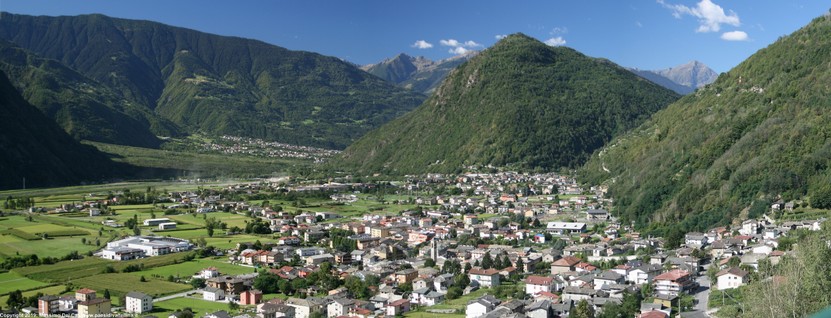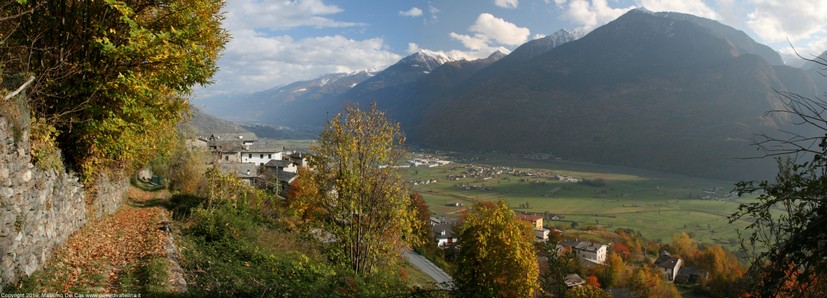My country
 | ||
Il comune di Ardenno è il primo paese della media Valtellina che si incontra procedendo in direzione di Colico (cioè da est ad ovest), ed è posto presso lo sbocco della Val Masino, sul versante retico, immediatamente ad est del punto nel quale il fondovalle valtellinese descrive una doppia curva, ad S, aggirando il caratteristico promontorio montuoso del Culmine di Dazio, o Colmen. Il suo nome è molto probabilmente connesso con la radice del verbo latino “ardere”, e quindi con il fuoco, ma il significato di questo nesso non è chiaro. Il diplomatico e uomo d'armi Giovanni Guler von Weineck, governatore per la Lega Grigia della Valtellina nel 1587-88, nella sua opera “Rhaetia” (Zurigo, 1616), così scrive, in proposito: “Alcuni ritengono che il nome di questo borgo sia derivato in antico dalla parola latina ed italiana ardere, perché durante l’estate il paese è tormentato da un caldo terribile; infatti è tutto esposto a mezzodì, né vi spira vento di sorte, a cagione della montagna di Pilasco che sorge a ponente. Quindi il clima è insopportabile, e perciò la nobiltà e la gente facoltosa, finché dura il caldo, cioè fino all’autunno, si trasferiscono in altri luoghi freschi e ventilati”. Le notazioni sul clima estivo sono, per la verità piuttosto esagerate, e l’ipotesi sul motivo della denominazione del paese non è l’unica. Il nome potrebbe, infatti, anche riferirsi al supplizio del santo patrono, S. Lorenzo, che fu martirizzato su una graticola, oppure alla presenza, nelle frazioni alte, di numerosi “piuàtt”, cataste particolari dalla cui lenta combustione interna si ricavava carbone di legna, o ancora, infine, da un episodio che risale ai tempi delle invasioni barbariche, quando una squadra di cavalieri che percorsero la valle tentò di dar fuoco alle case del paese, senza riuscirci, tanto che si udì gridare uno di loro “Arde-no, arde-no”. Lo storico settecentesco Francesco Saverio Quadrio così presenta il paese: “Ardeno (Ardena) Innocentemente si è scritto da alcuni essere stato tal luogo così nominato dall'Ardere per motivo del troppo caldo, che vi si prova. Diana è quella divinità, di cui gli Antichi resero il nome per Ardoina, Arduena, Artuenna. Arten, o meglio Harten in antichissima Lingua Teutonica voleva dire Foresta, come testifica il Wachter onde Hartuenna, o Hartuena, indi Harduenna, e Arduena veniva Diana appellata, quasi Dea delle Selve. Lo studioso Orsini, invece, ipotizza che "Ardenno" abbia la medesima origine del ben più celebre toponimo "Ardenne", in Belgio, e risalga ad "Arduinna", la dea celtica delle selve. Ciò testimonierebbe di insediamenti di matrice celtica. Il medesimo storico si spinge ad ipotizzare insediamenti ancora più antichi, risalenti all'ultimo neolitico o alla prima metà dell'età del ferro. Il luogo che giustifica l'ipotesi è il Caslàsc (Caslaccio), riportato su antiche carte pagensi, nei pressi dell'attuale Scheneno, quindi ad una quota approssimativa di 520 metri, sullo sperone posto proprio all'imbocco della Val Masino. Il toponimo, secondo lui, come quello di Caslido (località sul versante meridionale della Colma di Dazio), rimanda al concetto di "castelliere", ben distinto da "castello" (che si riflette, invece, nelle voci dialettali "castèel" e "catég"). Un castelliere è, in un certo senso, l'antenato del castello: si tratta di un piccolo villaggio fortificato, costituito da una torre centrale e da una cerchia di mura, di cui sono rimaste tracce, che rimandano ad epoche preistoriche, nell'Istria e nella Venezia Giulia. In epoca romana queste strutture furono utilizzate come fortilizi, spesso trasformati, infine, in epoca medievale, nei più conosciuti castelli. Se l'Orsini ha ragione, dunque, la zona di Scheneno era abitata già sin dalla fine dell'età della pietra. Ma si tratta solo di un'ipotesi toponomastica. |
Municipality of Ardenno is the first town in the average Valtellina that you come across by proceeding towards Colico (i.e. from east to west), and is located at the mouth of Val Masino, on the Rhaetian side, immediately east of the point where the Valtellina valley floor describes a double curve, to S, bypassing the characteristic mountainous promontory of Culmine di Dazio, or Colmen. Its name is most likely connected with the root of the Latin verb “to burn”, and therefore with fire, but the meaning of this connection is not clear. The diplomat and gunman Giovanni Guler von Weineck, governor for the Gray League of Valtellina in 1587-88, in his work "Rhaetia" (Zurich, 1616), writes in this regard: "Some believe that the name of this borgo is derived in ancient times from the Latin and Italian words to burn, because during the summer the town is tormented by a terrible heat; in fact it is all exposed to noon, and there is no wind of fate, due to the mountain of Pilasco which rises to the west. So the climate is unbearable, and therefore the parish church of San Lorenzo in Ardenno. Photo by Massimo Dei Cas www.paesidivaltellina.it the nobility and wealthy people, as long as the heat lasts, that is, until autumn, they move to other cool and breezy places ". The notes on the summer climate are, in truth, rather exaggerated, and the hypothesis on the reason for the name of the country is not the only one. The name could, in fact, also refer to the torture of the patron saint, S. Lorenzo, who was martyred on a grill, or to the presence, in the upper hamlets, of numerous "piuàtt", particular stacks from which slow internal combustion was obtained coal of wood, or, finally, from an episode that dates back to the times of the barbarian invasions, when a team of knights who crossed the valley tried to set fire to the houses of the village, without succeeding, so much so that one of them was heard shouting "Arde- no, it burns-no ". The eighteenth-century historian Francesco Saverio Quadrio presents the town as follows: “Ardeno (Ardena) Innocently it has been written by some that this place was so named by the Ardere because of the too hot it feels there. Diana is that divinity, of which the Ancients gave the name for Ardoina, Arduena, Artuenna. Arten, or rather Harten in ancient Teutonic language meant Forest, as Wachter testifies from which Hartuenna, or Hartuena, then Harduenna, and Arduena was called Diana, almost Goddess of the Woods. The scholar Orsini, on the other hand, hypothesizes that "Ardenno" has the same origin as the much more famous toponym "Ardenne", in Belgium, and goes back to "Arduinna", the Celtic goddess of the woods. This would testify to Celtic settlements. The same historian goes so far as to hypothesize even more ancient settlements, dating back to the late Neolithic or the first half of the Iron Age. The place that justifies the hypothesis is the Caslàsc (Caslaccio), reported on ancient pagens maps, near the current Scheneno, therefore at an approximate altitude of 520 meters, on the spur located right at the entrance of Val Masino. The toponym, according to him, like that of Caslido (locality on the southern slope of the Colma di Dazio), refers to the concept of "castelliere", well distinguished from "castle" (which is reflected, however, in the dialectal entries "castèel" and " catég "). A castelliere is, in a certain sense, the ancestor of the castle: it is a small fortified village, consisting of a central tower and a circle of walls, of which traces have remained, which refer to prehistoric times, in Istria. and in Venezia Giulia. In Roman times these structures were used as forts, often transformed, finally, in medieval times, into the most famous castles. If Orsini is right, then, the Scheneno area was already inhabited since the end of the Stone Age. But this is only a toponymic hypothesis. | |
 | ||
La frazione di Gaggio è un topònimo molto diffuso in Valtellina: tanto per non andare troppo lontano dalla frazione ardennese, un po’ più ad est, sul versante retico ed in comune di Berbenno, si trova il bel maggengo di Gaggio di Monastero. Tuttavia la frazione di Ardenno merita, probabilmente, la denominazione di Gaggio per eccellenza, sia per la bellezza del luogo, sia per aver dato i natali, nel 1786, al genio poliedrico di Pietro Ligari, considerato il più grande fra i pittori valtellinesi. L'etimo è dal latino medievale "gajum", che significa bosco (dal medesimo termine derivano il tedesco "wald" ed i longobardi "waldum" e "gualdum"). Il suo nome originario della località, però, è Arsizio, che significa arso, bruciato, mentre Gaggio era allora la denominazione della località più in alto, S. Rocco: nessuno ricorda più, oggi, l'antico nome, ma ne scrive, per esempio, ancora il vescovo di Como Feliciano Ninguarda, nel resoconto della sua visita pastorale in Valtellina del 1589: "Da un'altra parte c'è Arsizio, con otto famiglie, distante dalla matrice un miglio e mezzo... Nella parte più alta del monte c'è Gaggio, con 25 famiglie, con la chiesa di S. Rocco, distante dalla matrice quattro miglia". | The hamlet of Gaggio is a very common topònimo in Valtellina: so as not to go too far from the Ardennes hamlet, a little further east, on the Rhaetian side and in the municipality of Berbenno, is the beautiful mountain village of Gaggio di Monastero. However, the hamlet of Ardenno probably deserves the name of Gaggio par excellence, both for the beauty of the place and for being the birthplace, in 1786, of the multifaceted genius of Pietro Ligari, considered the greatest of Valtellina painters. The etymology comes from the medieval Latin "gajum", which means wood (the German "wald" and the Lombard "waldum" and "gualdum" derive from the same term). Its original name of the locality, however, is Arsizio, which means burned, burned, while Gaggio was then the name of the higher locality, S. Rocco: today no one remembers the ancient name, but writes about it, for example, again the bishop of Como Feliciano Ninguarda, in the account of his pastoral visit to Valtellina in 1589: "On the other side there is Arsizio, with eight families, a mile and a half away from the matrix ... In the highest part of the mountain there is Gaggio, with 25 families, with the church of S. Rocco, four miles away from the matrix ". | |






